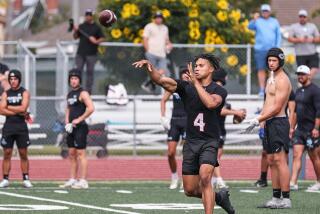It’s More Than a Game : Faced With Underfunded Programs and Urban Strife, Inner-City Coaches Play All the Positions--From Mr. Fix-It to Dad
- Share via
When Randy Rodriguez began as Lincoln High varsity football coach in 1984, he had to fill the gaping holes in the city’s eighth-oldest program, which has had more losing seasons than winning ones.
Although the Tigers have blossomed into one of the new powers in the City Section 4-A Division, Rodriguez still fills holes--the gopher holes that pockmark Lincoln’s field.
“I’m the gardener, water man, plumber, custodian,” Rodriguez said. “You would be surprised how much time I spend fixing that field.”
And that’s not to mention the time Rodriguez and his colleagues spend patching equipment, worrying about security and being surrogate fathers.
Welcome to the world of inner-city football.
That world takes in the traditional side of the sport, such as pep rallies, halftime bands, raucous fans and screaming coaches. But at schools, football also means dealing with recycled equipment and substandard playing conditions such as poor stadium lighting and fields with barely a blade of grass. And it means managing problems stemming from economically struggling communities in which gangs and drugs too often destroy the lives of young men.
At the center of the maelstrom is the football coach, who is expected to grapple with all this while creating a successful program. Yet the coaches persevere, knowing that their successes represent more than just winning records.
“We have many youngsters from single-family homes who have no male role model,” said Jefferson Coach Hank Johnson. “We have many youngsters on probation that we are constantly trying to counsel. When they beat the odds, especially the kids who grow up without much money or family support, it’s gratifying because you’ve done your job and given something back to the community.”
In recent years, the budget ax has fallen hard on high school football programs throughout metropolitan Los Angeles. But unlike many suburban schools where coaches can rely on booster clubs to pick up the slack for budget shortfalls, coaches in the Los Angeles Unified School District must make do with what little they have.
“I think budget cuts are the single biggest problems coaches have to deal with,” Johnson said.
Annual football budgets are determined by how much each program can come up with through ticket and concession sales, student activity fees, contributions and fund-raisers. Jordan, for example, operates on a budget of $3,600 a year; Crenshaw raises about $8,500 for its program. Loyola, a Catholic high school whose football team is ranked No. 1 in the state and fifth in the nation, has a $30,000-a-year program funded largely by donations. In comparison, Mater Dei, a football power in Orange County, budgeted $50,000 for equipment and transportation last year.
The paltry public school budgets create a variety of problems. Among them:
* At Lincoln, Rodriguez and his players spend several hours each week patching the field. For a while, they were only able to use it for practice. Home games were suspended after the rotted wooden stands were condemned Sept. 18 by school officials. The district has since earmarked enough money to rent portable bleachers, but whether the school can come up with about $80,000 to repair the permanent stands is in doubt.
* At Crenshaw, all 50 uniforms for the B-team were stolen from the school’s equipment room during the April-May riots. Coach Robert Garrett had to order new uniforms at a cost of $4,500. “I don’t know how I’m going to pay for them,” he said. “I may have to sell the uniforms to the kids to pay the bill.”
* At Jordan, coach David Richardson had to solicit donations from local colleges to get enough practice uniforms and weights for his team. “I had 14 players in the program (this summer) and 150 pounds of weights to work with,” he said. “By the start of the season, I had 73 players. I was short on helmets, practice pants, shoulder and thigh pads.”
“I think the general public’s perception is that coaches use their time to design great plays and draw Xs and O’s on a chalkboard,” said Tom Lunetta, 54, a Wilson coach for 13 years, including the last three as head coach. “The hardest thing about coaching is getting a team on the field and to overcome budget and legal constraints.”
The legal requirements include making sure players remain academically eligible to stay on the team. Many coaches say they have to monitor their players’ classroom attendance and make sure they get their homework done.
Often, that means 12- to 14-hour days, sometimes six days a week. For that service, coaches are paid their regular teaching salaries plus a stipend of $1,202 to $1,785 per season.
Johnson, 51, a high school head coach for 21 years who has been at Jefferson for the last seven, devotes his Saturday mornings to helping one of his players learn how to read. He also has given a former player money to purchase used books so he could attend East Los Angeles College.
“I told the player that once he made it, whether he became a teacher or whatever, that he had to bring his butt back to the inner city and help someone else,” Johnson said. “That’s how he could repay me.
“The kid started crying.”
The tears were illustrative of the strong emotional bond between coaches and players, many of whom are looking for a strong role model.
“Our football coach keeps us motivated and teaches us,” Jordan High linebacker Danny Vizcaino said. “He’s a man and he’s a friend too.”
Earl Jordan, a 17-year-old who is being raised by his grandfather, was one of the original 14 players on the Jordan team, but he didn’t play until the second game of this season. Jordan’s grandfather was concerned about Earl returning home late from games, but Richardson persuaded him to let the senior tailback compete.
Jordan has raised his grade-point average to 2.4 and plans to attend college next fall. He credits much of his classroom, football and off-campus success to his coach.
“I think of him as a father,” Jordan said. “He always says school first, then football, then other things. He stays on the players. If you make a mistake, he tells you a better way to do it. He doesn’t get on your case or put you down.
“If it weren’t for football, I would probably just go home, do my schoolwork, sit around and do nothing.”
Plain and simple, the players and coaches respect each other, and that is invaluable.
“Kids need somebody who they can trust due to their background, their home environment, past experiences and what have you,” Garrett said. “Some kids live at home with 20 other people. Getting a place to sleep is hard, getting a bath is hard. You don’t realize it until you get to the house and stay for dinner.”
Establishing respect in the community is often key to a coach’s success. When Jordan coach Richardson took over the team in March, he called meetings with parents, housing directors and rival gang leaders to recruit players and maintain a safe atmosphere at Jordan.
Maintaining a safe atmosphere has proven expensive for Richardson. Like other coaches, he must allocate funds to pay three security guards $40 an hour for a three-hour minimum and an additional $100 to the Los Angeles Police Department during each of Jordan’s six home games. Combined with the cost of having his team’s helmets refurbished, that left him with only $1,600 to purchase equipment, medical supplies and new uniforms.
As a result, Richardson contacted coaches at local universities and community colleges and asked for donations. Santa Monica College Coach Owen Hahn agreed to donate 40 pairs of practice pants, 30 sets of shoulder pads, 30 face masks and some extra helmets.
Richardson also contacted the L.A. Unified School District and received weightlifting equipment and nearly 2,000 pounds in weights from the Operation Fit Kids program.
Safety is also a concern at Dorsey, where the Dons have to walk from the school’s locker rooms across a park to reach Jackie Robinson Stadium.
“You have to think about little things that other people don’t talk about,” Knox said. “You have to know how to dress and to go and come back from the stadium. I have to go over things like what to do if there is gunfire outside the stadium. Things other coaches never have to talk about.”
The coaches say their desire to help their players is their main motivator. But despite their best efforts, players sometimes fall through the cracks.
“You see some youngsters that don’t make it,” Johnson said. “They end up in prison for selling drugs or end up dying because they were in the wrong place at the wrong time.
“When I was (coach) at Jordan, I had a couple youngsters that didn’t make it that had potential. It was a very difficult time. They develop a relationship with you. Many times the mother will call you and say something like, ‘Coach, I want you to speak at the funeral.’ It’s difficult to say no. I love them as my own son.”
Despite these difficulties, many coaches have winning programs.
Last season, for example, Crenshaw won its first title in the 3-A division, and Dorsey won its second 4-A Division championship. Dorsey has become such a powerhouse that the Dons could not put together a full schedule this season--prospective opponents, fearing they were outmatched, declined to play them.
Many coaches, beyond providing a positive outlet for teen-agers, are often instrumental in establishing bonds between schools and communities. Stan Johnson, a 31-year-old Fremont High graduate, has been coming to Dorsey games since Knox became coach in 1985. Johnson said he appreciates that Knox has kept players off the streets.
“It’s so easy for kids to stray away,” he said. “The dope, the easy money that can be made, the lack of father at home. There’re all sorts of excuses. But Coach Knox is a very smart guy and players respect him. . . . I know if I could play football again, I would run to Coach Knox.”
More to Read
Get our high school sports newsletter
Prep Rally is devoted to the SoCal high school sports experience, bringing you scores, stories and a behind-the-scenes look at what makes prep sports so popular.
You may occasionally receive promotional content from the Los Angeles Times.






